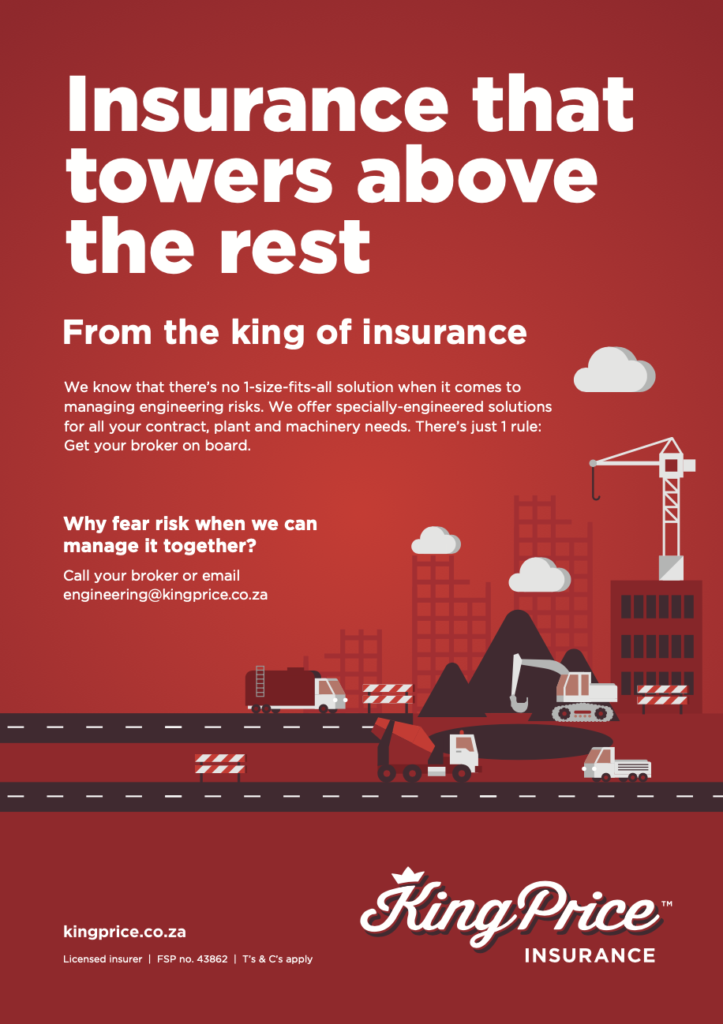By Rochelle De Lucia, CEO of King Price Insurance commercial and broker division

South Africa’s construction and engineering sector has struggled in recent years, seeing sharply reduced revenues and impaired cash flow due to a significant slowdown in construction work. However, the Construction Industry Development Board (cidb) reports that the sector is seeing an improvement in activity, with demand for new work increasing and profits looking healthier. According to the cidb’s latest SME Business Conditions Survey, having more on the order books has pushed confidence and activity over the long-term average. Supporting this outlook, the latest FNB/BER Civil Confidence Index shows that there’s ‘an upbeat expectation for activity’ in 2023, with confidence at a six-year high. This index, which reflects the state of business conditions in the civil engineering industry, predicts that the amount of available work will continue to trend higher.
All in all, this is great news for an industry that’s slowly letting out a collective sigh of relief.
While the dust settles around the big infrastructure tenders that are expected, there’s pressure on the sector to complete smaller projects, like roads, sub-stations and stormwater drains, and the SME sector is thriving. So, this is where we’ve decided to focus our engineering insurance product.
We’re reviving, simplifying and streamlining our engineering product to meet the needs of smaller contractors and projects, like plumbers, electricians, painters, building contractors, telecoms and fibre providers, and H-VAC and solar installers.
In the simplest possible terms, mission-critical assets must be protected against unforeseen incidents and accidents, and so we’ve made it our mission to make sure that our engineering cover does just that. Our four core engineering sections offer cover for these assets during different project lifecycle needs.
Our contractors’ all risks, and our transit and erection sections insure risks and assets during the installation or build. With a big focus on yellow metal, we also cover smaller machinery like rollers and compactors.
Once a project is handed over to the owner, we offer cover for machinery breakdown – for example, for loss of or damage to lifts, boilers and generators in commercial buildings, or for the filtration and temperature control systems needed in some factories. We also cover high-value, sensitive commercial electronic equipment, like large-scale printers.
Farsight and foresight
We’re very aware that rising interest rates and reduced lending sentiment from the banks are likely to pressurise bottom-lines, especially in the SME sector. To this end, we’ve adopted a ‘back to basics’ approach that enables even the smallest of players to cover all their risks in the most cost-effective way. All our commercial clients can tailor their policies by combining sections from our business, engineering, community and agri offerings to cover their unique day-to-day operational needs, as well as their cyber risks. This ensures that they have all the cover they need and don’t pay for cover that they don’t need.
Operationally, we’ve pulled our engineering division back into our larger commercial insurance structures and processes to take advantage of our scale, service capabilities, and skills base. As a commercial insurer, we take our relationships with our broker partners very seriously, and we rely on brokers’ specialised expertise to guide our commercial clients to make sound insurance decisions. Over and above this, we’re earning a reputation as an insurer that’s flexible and easy to do business with.
Looking forward, and notwithstanding our generally sluggish economy, the lingering effects of the pandemic, and the ongoing effects of loadshedding, the construction and engineering industry seems to be turning the corner. We’re in it for the long haul.


